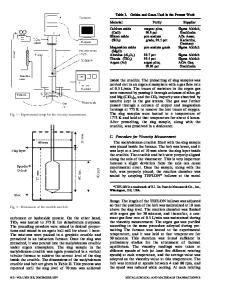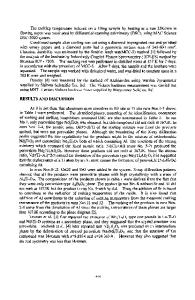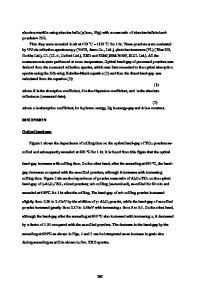TiO 2 -Al 2 O 3 nanocomposites
- PDF / 3,319,481 Bytes
- 6 Pages / 581 x 793 pts Page_size
- 57 Downloads / 441 Views
D. Coster Department of Chemistry, Laboratory for Surface Studies, University of Wisconsin-Milwaukee, P.O. Box 413, Milwaukee, Wisconsin 53210-0413
A. Sklyarov Advanced Analytical Facility, University of Wisconsin-Milwaukee, P.O. Box 413, Milwaukee, Wisconsin 53210-0413
S. Petit and J.J. Fripiata) Department of Chemistry, Laboratory for Surface Studies, University of Wisconsin-Milwaukee, P.O. Box 413, Milwaukee, Wisconsin 53210-0413 (Received 19 September 1994; accepted 26 January 1995)
Nanosized TiO2 is synthesized in a nanosized alumina matrix by a sol-gel procedure. The results of the study of the blueshift of the TiO2 UV band edge are compared to the information obtained from transmission electron microscopy (TEM). As long as the atomic ratio Ti/Al remains smaller than 17.5%, no individualized TiO2 particles are detected by TEM, in spite of the fact that no modification of the alumina structure occurs, as revealed by 27A1 MAS NMR. The shift of the UV band edge suggests the growth of homogeneous TiO2 domains in the alumina matrix. Above a critical radius, on the order of 1.2 nm, individual and crystalline TiO2 particles become visible in the TEM picture, and the porosity of the material decreases markedly.
I. INTRODUCTION When two metal oxides are coprecipitated, three possibilities may occur: (i) a solid solution is formed with oxobridges between the two metal cations: heterocondensation is favored; (ii) homogeneous domains of one oxide grow within the matrix of the other: homocondensation is preferred; or (iii) individual particles of one oxide are formed on the surface or in the pores of the second oxide. Measuring the size of the homogeneous domains or of the deposited particles [cases (ii) and (iii), respectively] presents a difficult challenge, especially when both oxides are amorphous and/or very fine grained. Domains of application of such measurements are important for fields as diverse as ceramic (nanocomposite) or catalysis. The present contribution deals with the characterization of mixed gel and oxides prepared by cohydrolyzing titanium and aluminum alkoxide. The pure aluminas prepared by limited hydrolysis of tri-sec-aluminum butoxide have been thoroughly characterized.1'2 The surface areas are large (generally larger than 350 m 2 /g), and the aluminum atoms exist in three states of coordination: four (A1IV), five (Al v ) and six (A1VI), as revealed by high resolution solidstate nuclear magnetic resonance (MAS NMR). The a) Author
1264
to whom correspondence should be addressed. J. Mater. Res., Vol. 10, No. 5, May 1995
http://journals.cambridge.org
Downloaded: 13 Mar 2015
material is x-ray amorphous. Electron diffraction shows broad diffuse rings and no spots. In the present contribution materials with overall compositions Ti/Al between 2.5% and 25% have been studied by 27A1 MAS NMR, differential thermal analysis (DTA), surface area and porosity measurement from N 2 adsorption and desorption isotherms, UV spectroscopy, transmission electron microscopy (TEM), and, eventually, electron diffra
Data Loading...











